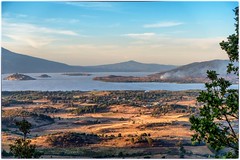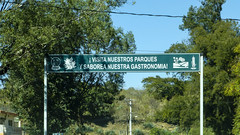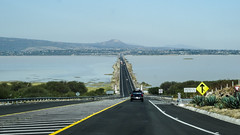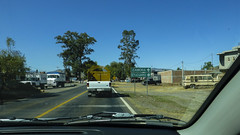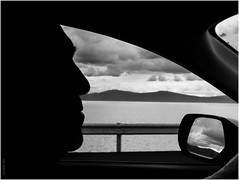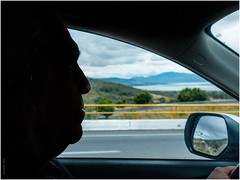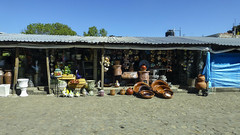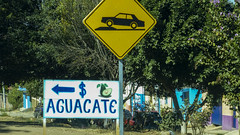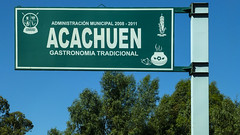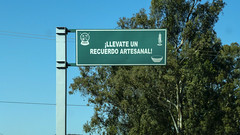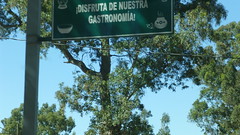Pátzcuaro
Pátzcuaro (Spanish: [ˈpatskwaɾo]) is a city and municipality located in the state of Michoacán. The town was founded sometime in the 1320s, at first becoming the capital of the Purépecha Empire and later its ceremonial center. After the Spanish took over, Vasco de Quiroga worked to make Pátzcuaro the capital of the New Spain province of Michoacán, but after his death, the capital would be moved to nearby Valladolid (today Morelia). Pátzcuaro has retained its colonial and indigenous character since then, and it has been named one of the 111 "Pueblos Mágicos" by the government of Mexico. Pátzcuaro, and the lake region to which it belongs, is well known as a site for Day of the Dead celebrations.
There are several possibilities as to the meaning of "Pátzcuaro." The first is "phascuaro," which means "place dyed in black;" or "patatzecuaro," which means "place of foundations." Another possible meaning is "petatzimícuaro," "place of bullrushes." Other possible meanings are: " happy place;" and "seat of temples." Pátzcuaro received its coat of arms in 1553 from Charles V of Spain.
History
The only history available about the founding of Pátzcuaro comes from the Relación de Michoacán written in 1539-1541, during the era of Viceroy Antonio de Mendoza. It states that two chiefs by the names of Páracume and Vápeani arrived in the area, then called Tarimichundiro, with their tribe, the Chichimecas. Here they began to build their temples, called "cues" by placing four large rocks close together. No date is given for this event, but since the deaths of the two original chiefs occurred in 1360, it is widely supposed that the founding occurred around 1324.
Around this time, three indigenous groups lived around Lake Pátzcuaro, who continuously fought each other. One group was called the "Coringuaro," another group the "Isleños" and the third the Chichimecas in Pátzcuaro. The Purépecha Empire began with Tariácuri, the first chief of the area assumed the title of "caltzontzin," or emperor, by conquering his neighbors. Pátzcuaro was the first capital of the Purépecha. The new kingdom was divided into three principalities called Ihuatzio, Tzintzuntzan and Pátzcuaro. Later, power shifted to the Tzintzuntzan principality, becoming the new capital, leaving Pátzcuaro as the ceremonial center, and a retreat for the nobility.
When the Spanish arrived in Michoacán, many sought refuge in Pátzcuaro. Forts were built in a neighborhood that is still called "Barrio Fuerte" (Fort Neighborhood). Fighting continued between the Purépecha and the Spanish. A meeting between the emperor Tanganxoan II and Cristóbal de Olid was arranged. Getting down off his horse, Olid embraced the monarch, then forced him to kneel in front of the crowd. Later a chapel was built which is called "El Humilladero" (The Place of Humiliation). In 1526, Nuño de Guzmán came as head of the new Spanish government to punish the Purépecha harshly. This culminated with the torture and death of Tanganxoan II the last Purépecha emperor. After this, most residents of Pátzcuaro fled to the mountains leaving the area mostly unpopulated. Vasco de Quiroga arrived in Pátzcuaro to take over. He expelled Nuño de Guzmán and confiscated his properties. Nuño was eventually sent back to Spain as a prisoner for his crimes in New Spain.
In 1538, the Spanish established their settlement in Pátzcuaro, founding the Diocese of Michoacán with Vasco de Quiroga as first bishop. Pátzcuaro was made the capital of the new Spanish province. The 1540s saw a repopulation of the area with Bishop Vasco de Quiroga convincing many of the Indians to return and brought in a number of Spanish families. For this Vasco de Quiroga is considered to be the founder of modern Pátzcuaro. He renamed the city as the City of Michoacán, which was confirmed by royal decree in 1553, with Pátzcuaro receiving its current coat of arms. The cathedral was constructed over the temple dedicated to the goddess Cueráppari. Vasco de Quiroga wanted to build an ambitious cathedral here, with five naves, but this was declared unacceptable by the Spanish crown and only one of the naves was built. It remains to this day. Pátzcuaro remained the largest city in the Spanish province until about ten years after Vasco de Quiroga's death. Viceregal authorities then decided to change the capital to the recently founded Valladolid (today Morelia) in 1575. Ecclesiastical authorities moved the diocese and the College of San Nicolás, established by Vasco de Quiroga, to Valladolid as well.
Pátzcuaro remained the economic and spiritual center of the Lake Pátzcuaro region with life dominated by Franciscan and Augustinian friars. In the mid 18th century, the city had a population of about 3,300 people. During the Mexican War of Independence, Pátzcuaro was attacked several times. Gertrudis Bocanegra was shot by firing squad for her participation in insurgent activities by royalist forces on the main square of Pátzcuaro on 10 October 1817. After Independence, the town was the capital of the 12th district of the West Department of Michoacán. In 1831, the state was reorganized and Pátzcuaro became the seat of the municipality of the same name. During the Reform War in 1867, Pátzcuaro sided with the Conservatives, who wanted to maintain the second Mexican empire. The city was then attacked by General Régules of the Republican side, who took possession of the town after a bloody fight and named liberal leaders.
During the Porfirio Díaz period, just before the Mexican Revolution, the Pátzcuaro area was heavily dominated by large landholders, haciendas and some foreign companies, pushing popular sympathy with the rebels to come. The town became a strategic point for taking the Michoacán capital. The town remained in rebel hands for most of the conflict but was taken in 1913 by Victoriano Huerta's government.
During the presidency of Lázaro Cárdenas (1934–40), who was from Michoacán, Pátzcuaro became a cultural center and national destination for tourism, building infrastructure to support the industry, creating public monuments and archeological excavations, and conservation of its colonial and indigenous look.
Town
Since the Mexican Revolution, Patzcuaro has worked to keep its traditional colonial-indigenous look. Unlike the capital, houses in Pátzcuaro are made of adobe and/or wood and generally have tiled roofs. Cobblestone streets dominate the center of town down to the lake. The town is filled with stores and vendors selling a wide variety of crafts, many in bright colors. Patzcuaro is the market hub of the region, with smaller villages bringing in their own specialized crafts such as copperware, black pottery, musical instruments, baskets etc. Local dishes include tamales or uchepos, filled with fish, tarasca soup, red pozole, atole, trout dishes, and a number of cold drinks based on corn. The courtyards and balconies are almost always filled with flowering plants, which is a tradition in Patzcuaro, with many homeowners sharing tips and plants with each other, sometimes even cross breeding a new variety of flower. The most common flower to be seen is the begonia, which blooms best between July and September. Other common plants include geraniums, mallows, bougainvilleas, , marigolds, azaleas, hydrangeas, roses and others. Non-flowering plants that can also be seen include palm trees, selaginella and various cacti. Some grow medicinal and culinary herbs such as aloe, chamomile, mint, basil and others.
The town center is called the Plaza Vasco de Quiroga or the Plaza Grande. This plaza is large considering the size of the town. The Plaza Grande was dedicated to Vasco de Quiroga in 1964, when a fountain containing a bronze statue of the bishop was placed in the center. This sculpture was done by Costa Rican artist Francisco Zúñiga. The Plaza is surrounded by old, stately ash trees and colonial-era mansions. Unlike most other towns and cities in Mexico, the main church does not face this plaza. While crafts can be seen for sale in all of the town, they are prominent in the Plaza. The main square is filled with stores selling a very wide variety of crafts including carved wooden statues and furniture, brightly painted accents depicting flowers and animals, brilliant piles of woven textiles, draperies, tablecloths, bedspreads and napkins, wooden figures, religious art, clay plaques and pots, polished wooden boxes and guitars, picture frames, woolen blankets, copper vases and platters, basketry and items made of woven straw and reed, and sculpted and scented candles. Many of these are on display in the shops set into the colonial buildings around the plaza, with much more inside.
Facing the main plaza is the Palace of Huitziméngari. This structure, like most of the rest of the town, is made of adobe and has a clay tile roof. This palace belonged to Antonio de Huitziméngari, the son of the last Purépecha cazonci (monarch), and the godson of the first viceroy of New Spain, Antonio de Mendoza. It has two floors, a sober facade and the inner courtyard is surrounded with round arches and filled with flowers. On the upper floor, there is a statue of a dog, an allusion to Huitziméngari's name which in Purépecha mythology referred to the dog that served the Lord of Paradise. The dog motif is repeated on some of the inside doors.
One block to the north of the Vasco Plaza is the Plaza Gertrudis Bocanegra, also called the Plaza Chica. The market off of Gertrudis Bocanegra specializes in woolen goods, kitchen implements, pottery, copper and straw items. Friday is market day, filling the walkways here with stalls with goods from various villages. Near main holidays, such as Day of the Dead, this market can spill over to the other two plazas in town as well. One of the buildings next to this plaza is the Ex Temple of San Agustin, which was founded in the 16th century. Today it houses the Gertrudis Bocanegra Library. This library has a mural painted by Juan O'Gorman depicting the histo…
Looking for places related to Pátzcuaro?
Those are other destinations to find places related to Pátzcuaro:

